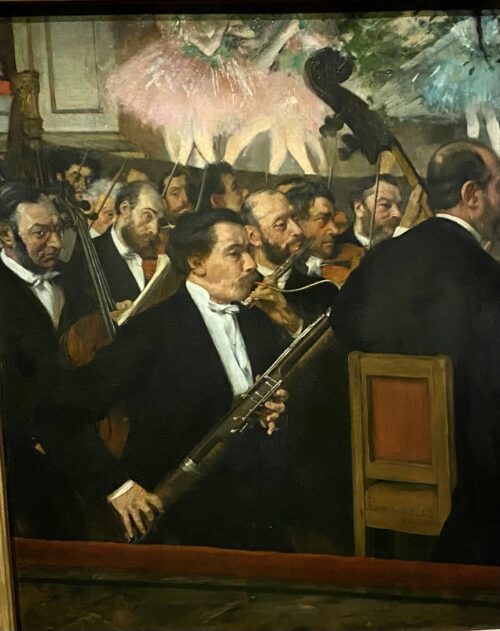
By David A. F. Sweet
NEW YORK – There are few bigger names in the world of Impressionism, if not art itself, than Edouard Manet and Edgar Degas. About 150 years after they first met, an exhibition has brought together many of their masterpieces for the first time.

Degas painted the Orchestra of the Opera around 1870.
Only four days after it opened, I visited the Manet/Degas exhibition, which was curated by The Metropolitan Museum of Art in New York and the Musées d’Orsay et de l’Orangerie in Paris. Why bring the works of the two Impressionists together? As the exhibition booklet explains, “Friends, rivals, and, at times, antagonists, (they) forged one of the most significant dialogues in nineteenth-century art. Their groundbreaking bodies of work would have been vastly different, if not unthinkable, without the creative exchanges that punctuated their careers.”
Both believed to be in their 20s when they met in the 1860s, their relationship featured plenty of drama. Perhaps the most vivid example is when Degas painted a scene of Suzanne Manet playing a piano while her husband was lost in reverie. When Degas visited the Manet’s apartment later, his jaw must have dropped as he saw the face of Mrs. Manet cut off from the painting along with a chunk of the right side of the work. Degas grabbed the butchered piece and left. Scholars suggest Edouard was outraged by the way his wife’s face looked in profile and created works of her he deemed far better.
Amazingly, the ruptured painting – which ended up hanging in Degas’ apartment – is part of the exhibit. It is odd to see colored paper where the rest of the painting should be. There are other fully complete works of the Manets elsewhere in the Met’s show – Manet and Degas painted themselves and family members quite a bit, mainly because they were wealthy enough not to need commissions.

Manet created 11 portraits of Berthe Morisot, seen here with a box of violets.
On the weekday morning when I traipsed up the Met’s grand staircase, the crowd inside the exhibition was thick. Fortunately, as one would expect, many of the paintings are gripping, featuring mesmerizing portraits, and entrancing scenes. A number of these famous works – there are more than 150 – once hung in The Salon in Paris. Some that were rejected were welcomed by the Salon des Refuses, created by Emperor Napoleon III in 1863 after The Salon had tossed aside the works of notable painters.
Traveling to New York for the first time since it was created in 1863 was Olympia. The painting shocked spectators during the 1865 Salon – not because she was nude, but because she wasn’t in any way tied to mythological nudes; she was a lady of the night staring straight at the viewer. Lashed by critics, ridiculed in cartoons, and denounced by art lovers – the painting was even moved higher so onlookers couldn’t ruin it with their walking sticks – Olympia stirred a frenzy. Manet was unable to sell the infamous work during his lifetime.

Degas painted this work of his friends the Manets — only to find it slashed during a visit to their house.
Surrounded by a massive gold frame, Olympia has a prominent, well-lit spot in the center of one of the Met’s rooms as you enter it — you can’t help but notice it. Unlike 19th-century Paris, however, the crowd was unperturbed in seen-it-all New York.
Unsung Gems Columnist David Sweet can be reached at dafsweet@aol.com.






